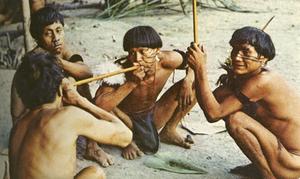Foragers
Has around 5-6km/Person and a good example is the Ju’Honsi of Kalahara
Foragers primarily eat by Gathering, hunting, and fishing. This was the predominant mode of production for 90% of human history. Today the only civilizations that exist that practice foraging live in marginal environments with scarce resources. The main advantage to the way foragers live is their added flexibility & mobility. Everything they own is portable and they only travel in small groups and live in small populations of around 12 – 100 in band and at most several thousand in culture group. They are land extensive. They take up a lot of land for a few people. Complementary gender roles are commonly associated with foraging as well as a minimal work day (as little as 5 hours a week). It is sustainable because it provides nature with time to replenish itself.
Horticulturalist
Horticulturalist has around 160 people for every square kilometer and a good example is the Yanamamo
Horticulturalist involves the Domestication of plants/animals complemented by foraging, trade with pastoralist for animal products. The usual Big crops are: Yams, corn, beans, grains, roots. They don’t use irrigation or portable hand tools. They use Shifting cultivation to allow land the time it takes to replenish nutrients. They generally operate in semi-permanent villages of 200-250. Horticulturalists are Land Extensive and use a lot of land for not too many people.
The divisions of labor with Horticulturalist are complementary in gender roles, there are appearances of status differential, and is more labor intensive then foraging. (12-20 hours per week). It is a sustainable mode of production because it provides nature time to replenish. However; problems arise when governments try to tax the horticulturist which forces them to attempt to grow more then nature allows and thus they use up all the land’s nutrients.
Pastoralist
Pastoralist generally have around 10 people for every square kilometer, this is due to the need for land for the herded animals. A good example of a Pastoralist civilization is the Nuer Herderi of Sudan
Atleast 50% of the Pastoralist diet originates from animals/by-products. They trade meat with horticulturists in exchange for horticulture. They travel in mobile groups; and it sometimes becomes dependent on herd animals. They are Land Extensive because their needs depend on grazing needs of each animal. First evidence of private property exists in the inheritance system in Pastoralism. The Division of Labor of Pastoralist is such that men herd larger animals, women herd smaller, children also herd young animals. This mode of production is also sustainable; because they use such a huge amount of land they allow time for areas to replenish naturally.



